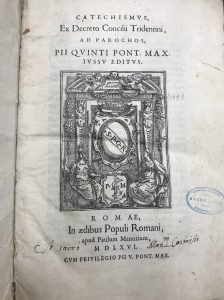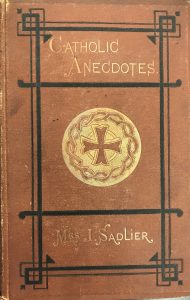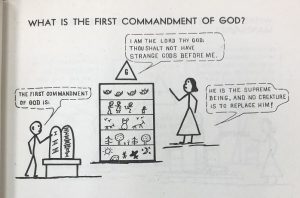The Rare Books Collection at The Catholic University of America contains many treasures among its 70,000 volumes, ranging from medieval documents to first editions of twentieth century authors. Among these are nearly 3000 Catholic catechetical texts: written works containing summaries of the beliefs of the Catholic faith compiled as teaching tools.

In one sense, these texts, which span from 1566 to the 1980s, are remarkably similar. The Catholic catechism has contained the same several parts for nearly 500 years: The Apostles Creed, The Lord’s Prayer, discussion of the seven sacraments (Baptism, Reconciliation, the Eucharist, Confirmation, Marriage, Holy Orders, Extreme Unction), and the Lord’s Prayer. But there were slight tweaks to the catechism over time. For example, as Berard Marthaler points outs, a “medieval fascination with numbers” caused theologian Hugh St. Victor to organize doctrine into units of seven as a mnemonic device. Hence, catechetical teaching of the time featured doctrine organized into units of seven: the seven capital sins, seven petitions to in the Lord’s Prayer, seven gifts of the Holy Spirit, seven Beatitudes, and seven virtues.[1]

By the Tridentine Era, so called for the Council of Trent that took place 1545-1563, a basic formula for the catechism was issued by the Council. This was partly due to the rise of Protestantism in Europe in the sixteenth century, but also due to a desire to teach the fundamentals of the faith on a regular basis using a uniform text. The Tridentine Catechism issued by the Council of Trent in 1566 contained the basics of the modern catechism: Apostles Creed, seven sacraments, Ten Commandments, and the Lord’s Prayer.

The uniform content of most of the catechisms produced after 1566, however, did not mean they would all look exactly the same. Coinciding with the rise of the printing press in Europe, the catechism could be reproduced in multiple languages, and with a variety of designs.
By the twentieth century, Pius X (Pope from 1903-1914) turned his attention to improving catechetical instruction once again, and emphasized greater uniformity in such instruction, and instruction in the sacraments at younger ages. Certainly, this would be more feasible as literacy spread throughout the Christian world, and as small, portable catechisms became easier to produce. The catechisms, uniform as they are in general content, reflect the cultures and trends from which they emerged.

The catechisms can be viewed by appointment; email: lib-rarebooks@cua.edu or call 202-319-5065.
[1] Berard Marthaler, Catechesis: “A Semantic Evolution”? Liturgical Ministry 18 (Winter 2009), 1-10, 4.
